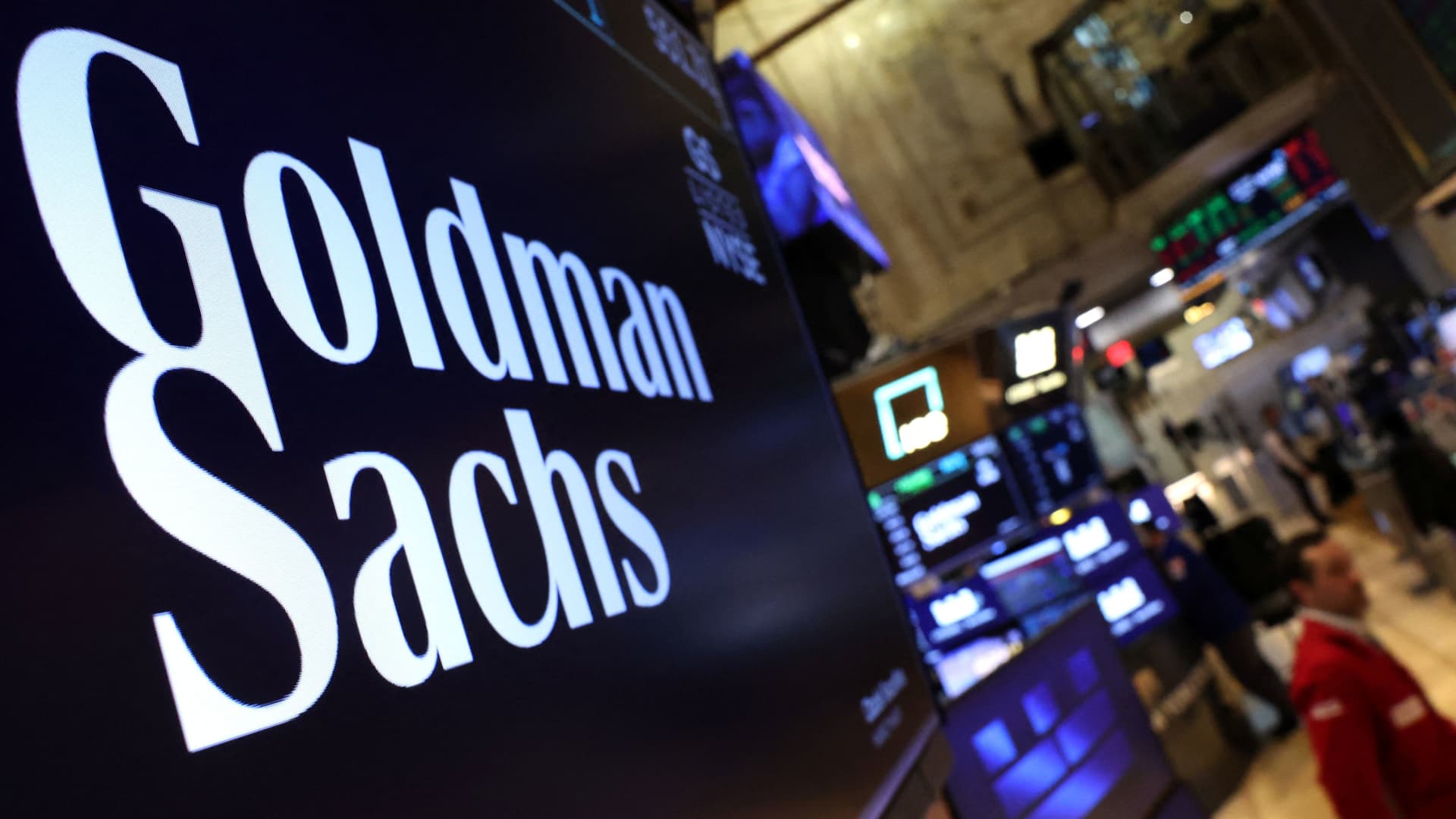Goldman Sachs ‘ better-than-expected quarterly results before Tuesday’s open and commentary on the post-earnings conference call give us confidence in the stock heading into 2026. Revenue in the third quarter ended Sept. 30 rose 19.6% year over year to $15.18 billion, topping the consensus estimate of $14.1 billion, compiled by data provider LSEG. Earnings per share (EPS) increased 45.8% year over year to $12.25, well ahead of the $11 estimate, according to LSEG. GS YTD mountain Goldman Sachs YTD Despite a pretty clean report across the board, shares of the world’s premier investment bank got off to a rough start and dropped more than 5.5% early in the session. Perhaps the reason was profit-taking in an overall market dragged down by renewed U.S.-China trade concerns. However, shortly after Goldman’s call began at 9:30 a.m. ET, the Club stock bottomed and so did the S & P 500 , which subsequently turned green. Goldman shares trimmed their losses. Investors must be mindful that nobody — President Donald Trump included — wants to see a full-blown trade war. And, for all the tough talk — some justified, some surely being viewed as a negotiating tactic — we must keep our focus on Goldman’s strong and strengthening fundamentals. With initial public offerings (IPOs) and mergers and acquisitions (M & A) set to further improve into next year, and deregulation as a tailwind, we see plenty of room for Goldman shares to run higher. Therefore, we are upgrading the stock back to our buy-equivalent 1 rating and increasing our price target to $850 per share from $750. While drifting lower from late September record highs, the stock was still up nearly 35% year to date — outperforming the S & P 500’s 13% advance. Bottom line This was a very strong quarter from Goldman Sachs, and any persistent weakness in its stock should be viewed as a buying opportunity. Though expenses were a bit higher than expected, that’s not a concern given the strong Q3 revenue and earnings. More importantly, the high-level metrics investors use to grade financial firms were all ahead of expectations. Goldman’s efficiency ratio came in below expectations, falling 3.2 percentage points versus the year-ago period — remember, lower is better here as the ratio is calculated as total non-interest expenses divided by net revenue. Return on tangible common equity and tangible book value per share both surprised to the upside. These three measures are key to determining the appropriate price-to-earnings multiple to put on financial firm earnings. Should we see trade negotiations with China work out and the economy hold in as the Federal Reserve works to keep inflation in check and support the labor market, Goldman’s third quarter stands to support a higher valuation multiple, which, along with earnings growth on the back of increased IPOs and M & A, should keep shares moving higher into 2026. Why we own it Goldman Sachs is our bet on a rebound in dealmaking as the regulatory environment improves under President Donald Trump. Investment banking is a big part of Goldman. Initiation date: Dec. 19, 2024 Most recent buy: March 19, 2025 Competitors: Morgan Stanley , JPMorgan , Bank of America , and Citigroup Another positive indicator of the bank’s ability to both invest in further growth while returning cash to shareholders is the common equity tier 1 (CET1) ratio of 14.4%, materially above the 10.9% minimum ratio for the firm. Speaking of growth investments, we want to quickly highlight that the firm announced the acquisition of Industry Ventures on Monday, for $665 million in cash and equity. Another $300 million will be payable based on Industry Ventures’ future performance through 2030. The deal is expected to close in the first quarter of 2026 and further diversify Goldman’s existing $540 billion alternative investment platform. Beefing up alternative assets is a trend on Wall Street as fellow Club BlackRock has been working to do the same. BlackRock also reported a strong quarter Tuesday morning. During the third quarter, Goldman repurchased 2.8 million shares, worth about $2 billion, and paid out $1.25 billion to shareholders via dividends. Companywide assets under supervision hit a new record at $3.45 trillion, with about $80 billion coming from market appreciation and another $79 billion from long-term net inflows since the second quarter. This marks the 31 st consecutive quarter of long-term, fee-based net inflows. Before digging further into the quarterly results, we thought this comment from CEO David Solomon on the call was particularly noteworthy as it relates to the broader market environment. “Taking a step back, there is no question that there is a fair amount of investor exuberance at the moment, with U.S. equity markets consistently hitting record highs over the last several months. Much of this has been fueled by a tremendous amount of investment in AI infrastructure, which has driven significant capital formation. But as students of history, we know that following periods of broad-based excitement around new technologies, there will ultimately be a divergence where some ventures thrive and others falter. While I feel good about the forward outlook on balance, the market operates in cycles, and disciplined risk management is imperative. We are especially vigilant in times like these to proactively manage risks as we continue to serve clients with our best-in-class execution capabilities and insights,” Solomon said. Goldman Sachs is one of the best risk managers, if not the best, in the world, and we think all investors would do well to keep Solomon’s words top of mind. Yes, some of the artificial intelligence winners will continue to win. We, obviously, believe in the names in the Club portfolio. However, there is no denying that parts of the market are becoming increasingly frothy, and many of the speculative names being bid up right now may well not exist 10 years from now. The Club does not own any of those stocks. As a result, members should think about their own portfolio exposure and risk management protocols as they relate to AI exposure. Commentary Goldman’s global banking and markets division saw revenue in the third quarter increase 18% year over year (YoY) to $10.12 billion, well ahead of expectations. Revenue from investment banking, the biggest part of the segment, surged 42% year over year, benefiting from “significantly higher” advisory (up 60% YoY) and debt (up 30% YoY) underwriting revenue versus the year-ago period, along with an increase in equity underwriting revenue (up 21% YoY). On the call, Solomon sounded optimistic about the investment banking landscape, saying, “M & A activity creates a real multiplier effect — whether it’s bridge financing, derivative hedging, investment opportunity, and asset management.” He added, “It’s clear from our conversations in boardrooms and after a period of heightened uncertainty and volatility early in the year, many of our clients navigated and adapted to the current state of play. Though near-term policy considerations are still relevant, many CEOs have shifted their focus back to long-term and strategic decision-making. Particularly amid a more supportive regulatory environment.” Fixed income, currency, and commodities revenue came in at $3.47 billion, 17% above last year’s level, and above the $3.12 billion expected. The strong result reflects very strong intermediation revenue (up 21% YoY), compounded by strong financing results (up 9% YoY). Equities revenue increased 7% year over year, with “significantly higher” financing revenue (up 33% YoY) versus the year-ago period, being only partially offset by a decrease in intermediation revenue (down 9% YoY). Third-quarter revenue in the asset and wealth management division advanced 17% from a year ago, and 16% sequentially. Total management and other fees increased 12% year over year, thanks to a 6% increase in asset management fees and 17% increase in wealth management fees. The fee growth largely reflects an increase in assets under supervision. Private banking and lending fees surged 40% year over year, while debt investments revenue was up 9% versus the year-ago period. Inventive fees, on the other hand, were down 9% year over year. Platform solutions revenue in Q3 outpaced expectations, surging 71% year over year, though it did fall 2% sequentially. An 80% increase in consumer platforms revenue was compounded by a 22% increase in transaction banking and other revenue. Though the growth rates are impressive, it should be noted that the consumer platform growth benefits from the transfer of the bank’s General Motors credit card program to “held for sale” status. While still solid and ahead of expectations, the growth rates in this line item can’t be extrapolated out as they reflect the lapping of one-time issues. (Jim Cramer’s Charitable Trust is long GS, BLK. See here for a full list of the stocks.) As a subscriber to the CNBC Investing Club with Jim Cramer, you will receive a trade alert before Jim makes a trade. Jim waits 45 minutes after sending a trade alert before buying or selling a stock in his charitable trust’s portfolio. If Jim has talked about a stock on CNBC TV, he waits 72 hours after issuing the trade alert before executing the trade. THE ABOVE INVESTING CLUB INFORMATION IS SUBJECT TO OUR TERMS AND CONDITIONS AND PRIVACY POLICY , TOGETHER WITH OUR DISCLAIMER . NO FIDUCIARY OBLIGATION OR DUTY EXISTS, OR IS CREATED, BY VIRTUE OF YOUR RECEIPT OF ANY INFORMATION PROVIDED IN CONNECTION WITH THE INVESTING CLUB. NO SPECIFIC OUTCOME OR PROFIT IS GUARANTEED.





